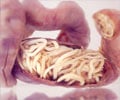A study analyzed cases of a parasitic lung infection and found new modes of transmission and associated behaviors, identifying new groups of people at risk.

The one indigenous Paragonimus species can transmit infection through undercooked mudbugs at a crawfish boil and through exposure while floating, paddling, canoeing or camping on waterways and in areas where crawfish live. Some cases have followed consumption of raw crawfish while intoxicated. A person can become ill from eating only one. Less commonly, the parasite has been transmitted by contaminated food utensils and consumption of undercooked meat from infected animals. The incubation period can vary from 2-16 weeks. Although some people can remain asymptomatic for prolonged periods, this parasitic infection can produce symptoms ranging from fever, recurrent cough, and night sweats, mimicking tuberculosis, to bloody cough, pleurisy, and pneumonia. It can cause headaches, seizures, stiff neck, and loss of vision. It can also result in death.
The Centers for Disease Control and Prevention and the US Food and Drug Administration now advise cooking or boiling crawfish to reach an internal temperature of 145° F. before eating. Other prevention strategies include frequent hand-washing when preparing crustaceans, avoiding contamination of utensils and serving platters, as well as cooking crustaceans to the recommended temperature of 145°F. New laboratory and other diagnostic tests can confirm infection with Paragonimus parasites, and there is effective treatment available.
"Doctors should consider this infection in vacationers and weekenders returning from areas of the US where the parasite is endemic and ask about raw or undercooked crawfish in all patients with unexplained fever, cough, high white blood cell count, and fluid around the lungs," notes Dr. Diaz, who is also an assistant professor of Family Medicine at the LSUHSC School of Medicine. "Even without microscopic evidence, any patient with a positive history of raw or undercooked freshwater Asian crab or native crawfish and clinical symptoms should be evaluated and treated to prevent serious complications."
Source-Eurekalert













